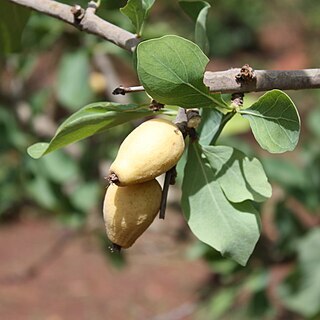A shrub. It grows 1-2 m high. It branches from near the base. It loses its leaves during the year. The bark is pale yellow. Young shoots have a grey covering. The leaves are in rings of 3 at the ends of shoots. They are 12 cm long by 10 cm wide. They vary in shape. The flowers occur singly and are white to yellow. They have a scent. The tube of the flower is 5 cm long. The fruit are 3-5 cm long and oval but slightly bent. They are pale yellow when ripe.
A savanna shrub, or small tree, to 10 ft. high, rarely more
Flowers white, turning yellow, fragrant
Fruits yellow when ripe, edible.


